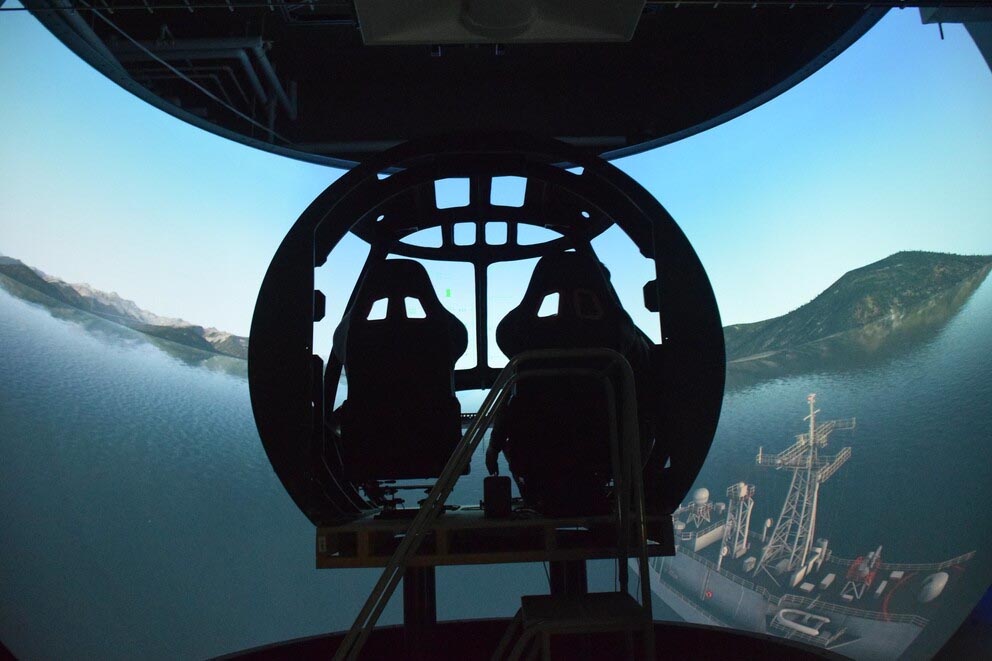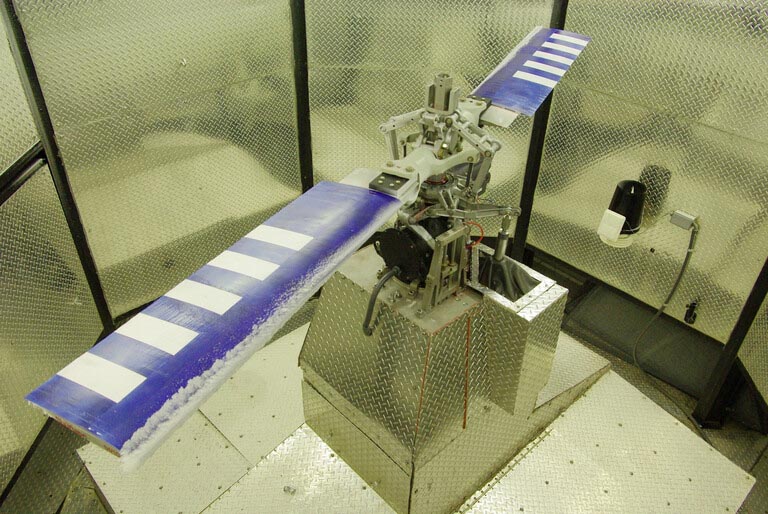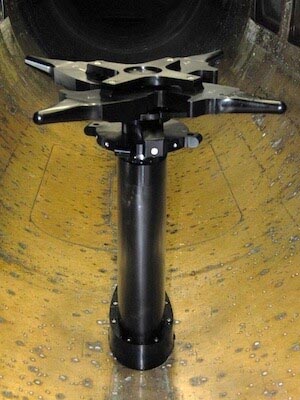
The Penn State Vertical Lift Research Center of Excellence houses a full-motion base rotorcraft flight simulator in Hammond Building. The facility allows researchers to investigate real-time flight dynamics, controls and handling qualities. IMAGE: PENN STATE COLLEGE OF ENGINEERING
Penn State Vertical Lift Research Center of Excellence renewed for sixth time
The renewal guarantees five more years of funding as one of three such centers in the United States
8/9/2021
By Ashley J. WennersHerron
UNIVERSITY PARK, Pa. — The Penn State Vertical Lift Research Center of Excellence (VLRCOE) was awarded another five years of funding through a cooperative agreement with the U.S. Army, U.S. Navy and NASA. In its 25th year as one of three such centers in the United States, VLRCOE received about $7.5 million to investigate 10 new tasks related to vertical lift technology and related educational activities over the next five years. Penn State will cost share $3.3 million for this work, totaling $10.8 million in new funding.
“The mission of the center is to understand and break through the barriers the vertical lift community faces, such as higher speeds, longer ranges and lower operating costs for vertical lift vehicles,” said Edward Smith, VLRCOE director and professor of aerospace engineering at Penn State. “Now, we have the good news of receiving another five years of support from major agencies. This funding helps us match the strengths and expertise of Penn State faculty and facilities with the questions and goals of vertical lift research.”
Launched in 1996, the VLRCOE has successfully competed for continued funding every five years. While the five-year cooperative agreement funding is not the sole funding source for the center, it is what allows the center to retain its national title, shared with the University of Maryland and Georgia Tech.

This 10-foot diameter hover stand resides in a climatic chamber where aircraft icing conditions can be reproduced. The rotor can be spun up to 1,200 rotations per minute at temperatures as cold as -20 degrees Celsius. IMAGE: PENN STATE
The contract also provides an additional mechanism by which Penn State can collaborate with partner universities to expand their impact in vertical lift research and their work to educate the next generation of vertical lift engineers. For the 10 funded tasks, three partner universities were named: Auburn University, University of Tennessee and the University of California, Davis. The faculty investigators at the partner universities are all alumni of the Penn State program.
“Our work in the VLRCOE is more than just this contract,” Smith said, “The contract designates the center as one of the country’s leading institutes, but it comes with an expectation that we will use our facilities and faculty to engage and recruit the best and brightest students.”
Part of the funding will be used to recruit about 15 students a year to conduct their master's or doctoral degree research. Each student is co-advised by more than one faculty member, often by teams of advisers spread across Penn State and the partner universities.
“Vertical lift projects are incredibly multidisciplinary,” Smith said. “The questions of interest require the expertise of two or three faculty members from different focus areas. The result is a much more effective and rewarding experience for the students and the faculty.”
The funding is also used to make the center’s annual comprehensive short course in rotary wing technology — which has taken place annually for 53 years — free for all students from any university.
The most recently funded projects are focused on investigating and advancing aeromechanics, flight dynamics and control, propulsion, and safety and survivability. Citing defense to delivery drones to Dragonfly, the quadcopter that will help explore Saturn’s moon Titan, Smith said the potential findings will have limitless applications.
“Here at Penn State, we’ve been working on vertical lift since the 1960s; we’ve had the center since the 1990s — haven’t we figured it out yet?” Smith asked. “Our vision is long term. People thought the horse and buggy was the height of technology until the automobile came along, and now we’ve moved from the Model T to the Tesla. With vertical flight, there are profound challenges and changes we’re addressing.”
The funded projects are:
Proprotor and Wing Interactional Aerodynamics for Performance, Acoustics, and Vibration
Project leads:
- Ken Brentner, VLRCOE administrative director and professor of aerospace engineering, Penn State
- Seongkyu Lee, associate professor of mechanical and aerospace engineering, University of California, Davis
Scaling for Interactional Aerodynamics and Acoustics of Multirotor Systems
Project leads:
- Eric Greenwood, assistant professor of aerospace engineering, Penn State
- Mark Miller, assistant professor of aerospace engineering, Penn State
- Jose Palacios, associate professor of aerospace engineering, Penn State
Fundamental Interactional Aerodynamics of Low-Drag Rotor Hub/Pylon Flows
Project leads:
- James Coder, assistant professor of aerospace engineering, University of Tennessee
- Nicholas Jaffa, Applied Research Laboratory, Penn State
- David Reich, Applied Research Laboratory, Penn State
- Sven Schmitz, associate professor of aerospace engineering, Penn State
Cold Spray Deposition of Polymer-Coated Metal/Ceramic Particles on CFRPs for Improved Erosion Resistance
Project leads:
- Douglas Wolfe, Applied Research Laboratory, Penn State
- Namiko Yamamoto, associate professor of aerospace engineering, Penn State
Adaptive Pilot Modeling for Shipboard Operations
Project lead:
- Joseph Horn, professor of aerospace engineering, Penn State
State-Variable Implementation and Linearization of Simulations with Multi-Disciplinary Aeromechanics
Project leads:
- Ken Brentner, VLRCOE administrative director and professor of aerospace engineering, Penn State
- Joseph Horn, professor of aerospace engineering, Penn State
- Umberto Saetti, assistant professor of aerospace engineering, Auburn University
Acoustically Aware Vertical Lift Autonomy
Project leads:
- Ken Brentner, VLRCOE administrative director and professor of aerospace engineering, Penn State
- Eric Greenwood, assistant professor of aerospace engineering, Penn State
- Jack Langelaan, professor of aerospace engineering, Penn State
Electrified, Variable Speed Rotorcraft Drivetrain Concepts for Enhanced Vehicle Performance
Project leads:
- Robert Bill, research associate, aerospace engineering, Penn State
- Hans DeSmidt, professor of aerospace engineering, University of Tennessee
- David Hall, assistant professor of aerospace engineering, Penn State
- Edward Smith, VLRCOE director and professor of aerospace engineering, Penn State
Semi-Passive, Low Power Ice Protection for eVTOL
Project leads:
- Jose Palacios, associate professor of aerospace engineering, Penn State
- Douglas Wolfe, Applied Research Laboratory, Penn State
Human-Intuitable Collision Avoidance for Autonomous and Semi-Autonomous Rotorcraft
Project leads:
- Jack Langelaan, professor of aerospace engineering, Penn State
- Alan R. Wagner, Hartz Family Career Development Assistant Professor of Aerospace Engineering, Penn State




